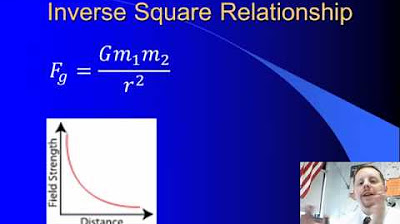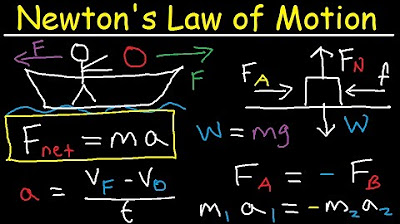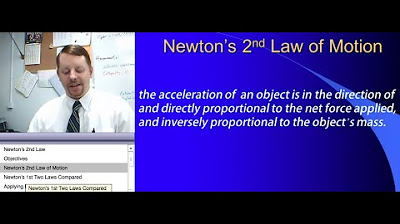High School Physics - Newton's 3rd Law
TLDRIn this informative talk, Mr. Fullerton explores Newton's third law of motion, the principle of action and reaction. He explains that forces always occur in pairs, with one object exerting a force on another, and the second object exerting an equal and opposite force in response. Using everyday examples like pushing a wall, the interaction between the cat and the ground, and swimming, he illustrates how this law operates in our surroundings. Fullerton also discusses action-reaction pairs in scenarios such as a girl kicking a soccer ball, a rocket engine in space, and the gravitational forces between the Earth and the Moon. The session concludes with problem-solving exercises to reinforce the concept and encourage active application of Newton's third law.
Takeaways
- 📜 Newton's third law of motion, also known as the action-reaction law, states that all forces come in pairs, with each object exerting a force on the other that is equal in magnitude and opposite in direction.
- 👊 When you exert a force on an object, such as punching a wall, the object exerts an equal and opposite force back on you, which can cause harm or discomfort.
- 🧍♂️ Pushing against a surface, like a desk, results in a reaction force from the desk back onto your hand, illustrating the concept of action and reaction forces.
- 🐱 The motion of a cat running forward is due to its action of pushing backward against the ground, which in turn propels the cat forward as a reaction.
- 🏊♂️ In swimming, to move forward, one must push against the water backward, and the water's reaction force propels the swimmer forward.
- 🚀 A rocket ship in space uses the action-reaction principle by expelling gases outward, which in turn propels the rocket forward.
- 🌍 The gravitational force between the Earth and the Moon is an example of action-reaction pairs, with the Earth's gravity pulling the Moon and the Moon's gravity pulling back on the Earth with equal forces.
- 👧 When a girl kicks a soccer ball, the force she applies to the ball is met with an equal and opposite force exerted by the ball on her foot.
- 🛳️ A girl pushing a sailboat with her force of 100 Newtons will experience an equal and opposite force of 100 Newtons from the sailboat.
- 🔨 A hammer hitting a nail demonstrates the action-reaction pair where the force of the hammer on the nail is equal in magnitude to the force of the nail on the hammer during contact.
- 🔍 Identifying action-reaction pairs in various scenarios, such as a car speeding up on a highway, a coffee mug on a table, or a frog on a lily pad, helps to understand the application of Newton's third law in everyday situations.
Q & A
What is Newton's third law of motion?
-Newton's third law of motion states that for every action, there is an equal and opposite reaction. This means that if an object exerts a force on another object, the second object exerts an equal force in the opposite direction on the first object.
How does Newton's third law relate to forces coming in pairs?
-Newton's third law indicates that forces always come in pairs, known as action-reaction pairs. One object's action (exerting a force) is always met with a reaction from the other object. These forces are equal in magnitude but opposite in direction.
Can you provide an example of Newton's third law from the script and explain it?
-An example from the script is when you punch a wall with a force of 100 Newtons. The wall exerts an equal force of 100 Newtons back on your hand, which is why your hand hurts. This demonstrates the action-reaction pair where the action is the force exerted by the hand on the wall, and the reaction is the force exerted by the wall on the hand.
How does the script illustrate the concept of action-reaction pairs in daily life?
-The script uses several examples from daily life to illustrate action-reaction pairs, such as pushing on a desk, a cat pushing back on the ground to move forward, or a swimmer pushing back on the water to move forward. These examples show how forces are interactive and always occur in pairs, affecting the objects involved in opposite but equal ways.
What is the significance of understanding action-reaction pairs in physics?
-Understanding action-reaction pairs is crucial in physics because it forms the basis for analyzing and solving dynamics problems. It helps in predicting the behavior of objects when forces are applied and in calculating the effects of these forces on the objects involved in the interaction.
How does the script explain the concept of forces in relation to the Earth and the Moon?
-The script explains that the Earth's gravitational force on the Moon and the Moon's gravitational force on the Earth are an action-reaction pair. Despite the difference in their masses, the forces they exert on each other are equal in magnitude and opposite in direction, as per Newton's third law.
What is the relationship between the girl's weight and the force she exerts on the sailboat in the script's example?
-The girl's weight, which is 400 Newtons, is mentioned to specify her mass, but it is not the force she exerts on the sailboat. The force she applies to push the sailboat is 100 Newtons. The sailboat exerts an equal and opposite force of 100 Newtons back on the girl, as per Newton's third law.
How does the script use the example of a rocket to explain Newton's third law?
-The script uses the example of a rocket to show how Newton's third law enables propulsion. The rocket engine expels gases outwards, and these gases exert a force on the rocket in the opposite direction. This reaction force is what propels the rocket forward, illustrating the action-reaction principle in motion.
What is the action-reaction pair in the scenario of a frog sitting on a lily pad floating on a pond?
-The action-reaction pair in this scenario involves the frog and the lily pad. The frog exerts a force downwards due to gravity when it sits on the pad. In response, the lily pad exerts an equal and opposite force upwards on the frog, keeping it afloat.
How many action-reaction pairs can be identified in the example of a car speeding up on the highway?
-Multiple action-reaction pairs can be identified in this scenario. For instance, the tires exert a force on the road to propel the car forward, and the road exerts an equal and opposite force on the tires. Additionally, the engine exerts a force on the car to accelerate it, and the car exerts an equal force on the engine. Air resistance also plays a role, with the air exerting a force on the car and the car exerting a force on the air.
What is the significance of the action-reaction pair in the context of a coffee mug sitting on a table?
-The action-reaction pair in this context involves the coffee mug and the table. The mug exerts a force downwards due to gravity (its weight), and the table exerts an equal and opposite force upwards, supporting the mug. This interaction prevents the mug from falling through the table.
Outlines
📚 Introduction to Newton's Third Law
This paragraph introduces Newton's Third Law of Motion, also known as the law of action and reaction. It explains that forces always occur in pairs, with object one exerting a force on object two, and object two exerting an equal and opposite force back on object one. The concept is illustrated with everyday examples, such as punching a wall, pushing on a desk, and the interaction between the cat and the ground, as well as the swimmer and the water. The law is mathematically expressed, and its application in various scenarios, like jumping, is discussed. The paragraph sets the stage for a deeper understanding of the law and its implications in solving dynamics problems.
🤔 Examples of Action-Reaction Pairs
This paragraph delves into specific examples of action-reaction pairs to further illustrate Newton's Third Law. It describes scenarios such as a girl kicking a soccer ball, a rocket ship maneuvering in space, and the universal interaction between gravity and objects on Earth. The paragraph emphasizes that these pairs are manifestations of the law and are observable in our daily lives. It also poses a series of sample problems to test the understanding of the law, involving the gravitational forces between the Earth and the Moon, a girl pushing a sailboat, and a carpenter hitting a nail with a hammer. The aim is to reinforce the concept that forces always come in pairs, as per Newton's Third Law.
💡 Identifying Action-Reaction Pairs in Scenarios
The final paragraph challenges the understanding of Newton's Third Law by asking to identify action-reaction pairs in various scenarios. It presents three situations: a car speeding up on a highway, a coffee mug sitting on a table, and a frog sitting on a lily pad in a pond. The exercise is designed to help participants recognize the application of the law in different contexts and to think critically about the forces at play. The paragraph concludes by encouraging further exploration of physics concepts and offering assistance for any questions that may arise.
Mindmap
Keywords
💡Newton's Third Law of Motion
💡Force Pairs
💡Action-Reaction Pairs
💡Dynamics Problems
💡Magnitude
💡Direction
💡Cat and Ground
💡Rocket Engine
💡Sailboat and Girl
💡Carpenter and Nail
💡Identification of Action-Reaction Pairs
Highlights
Newton's third law of motion, also known as the law of action-reaction, states that all forces come in pairs.
If object one exerts a force upon object two, then object two must exert an equal and opposite force back on object one.
The example of punching a wall illustrates how the action-reaction force pair can cause harm to the person exerting the force.
The concept of action-reaction force pairs can be observed when pushing a hand against a desk, leaving an indentation in the hand due to the desk's force.
Mathematically, the force of object 1 on object 2 is equal in magnitude and opposite in direction to the force of object 2 on object 1.
The cat running forward is an example of Newton's third law, where the cat pushes backward on the ground, and the ground pushes the cat forward.
Swimming and jumping are activities that demonstrate Newton's third law, as one must push in one direction to move in the opposite direction.
Action-reaction pairs are present in everyday situations, such as when a girl kicks a soccer ball or a rocket engine expels gases to move forward.
Even sitting still involves action-reaction pairs, as gravity pulls on a person, and the person pulls on the Earth with an equal force.
The Earth's gravitational force on the Moon and the Moon's gravitational force on the Earth are equal in magnitude and opposite in direction, according to Newton's third law.
A 400 Newton girl exerts a force of 100 Newtons on a 10,000 Newton sailboat, and the sailboat exerts an equal and opposite force back on the girl.
The force the hammer exerts on the nail and the force the nail exerts on the hammer during contact are equal in magnitude, as per Newton's third law.
The car speeding up on the highway involves action-reaction pairs related to the engine's force and the frictional force from the road.
A coffee mug sitting on a table demonstrates action-reaction pairs between the mug's weight and the table's support force, as well as the atmospheric pressure.
A frog sitting on a lily pad floating on a pond involves action-reaction pairs, including the frog's weight, the buoyant force from the water, and the lily pad's support force.
Identifying action-reaction pairs in various scenarios helps to understand and apply Newton's third law in solving dynamics problems.
Transcripts
Browse More Related Video
5.0 / 5 (0 votes)
Thanks for rating:





